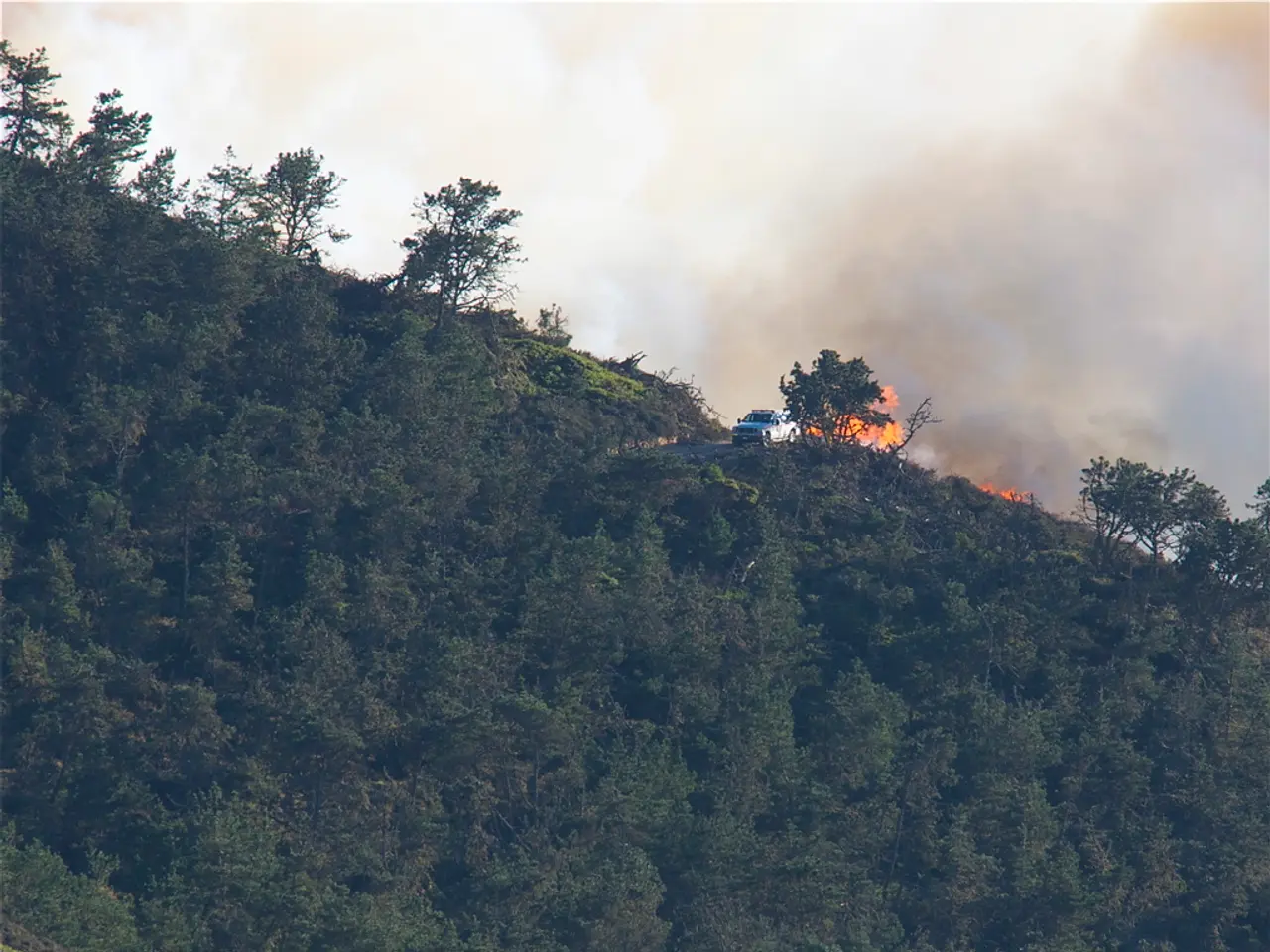Northern Colorado grapples with choking smoke, intense heat, and elevated fire danger
Health and Safety Alert: Wildfire Smoke, Extreme Heat, and High Wildfire Danger in Northern Colorado
Residents in Northern Colorado are advised to take precautions as they face a confluence of health and safety threats due to wildfire smoke, extreme heat, and high wildfire danger. These conditions are expected to persist at least through mid-August 2025.
Air Quality Health Advisories are active in multiple counties, including Larimer, Garfield, Mesa, Rio Blanco, Routt, and the northern Front Range areas. Residents are urged to remain indoors if smoke is thick, especially vulnerable groups such as those with heart or respiratory conditions, young children, and older adults.
Limiting outdoor activities when smoke levels are moderate to heavy is recommended to reduce exposure to fine particulate matter (PM2.5) that significantly increases health risks. If indoor smoke exposure causes health issues, consider temporarily relocating. Visibility under 5 miles due to smoke indicates unhealthy air quality levels for which residents should take precautions.
Due to extreme drought and critically dry fuels, wildfire danger remains high, prompting a fire weather advisory through at least mid-August. This advisory warns of rapid fire spread, torching, and resistance to fire suppression due to dry conditions and heat.
Air quality alerts for wildfire smoke are currently set to remain through at least August 13, 2025, in specific areas, and wildfire activity continues with large fires actively burning and only partially contained. Extreme drought and critical fire weather conditions are expected to persist through mid-August, sustaining elevated wildfire risks and smoke impacts.
Smoke contributions from both local wildfires and distant fires have triggered an Action Day Alert across the Front Range Urban Corridor, advising sensitive groups to reduce outdoor exertion. Danger factors include high temperatures, gusty winds, and extremely low humidity levels, which could lead to a perfect storm for wildfire ignition and rapid spread.
To cope with the heat, if indoor heat becomes oppressive, visiting air-conditioned public spaces like libraries or shopping centers is suggested. Temperatures will begin to decline into the weekend, offering a glimmer of relief. On Saturday, August 9, the temperature will be noticeably cooler at 85°F/29°C, but it will be mostly cloudy with a chance of afternoon thunderstorms.
Residents are advised to stay informed via the National Weather Service and Colorado Department of Public Health and Environment. Red Flag Warnings and Heat Advisories are in effect across Northern Colorado, including Larimer, Boulder, Weld, Jackson counties, and the Denver metro, through Friday, August 8. On Sunday, August 10, temperatures will ease further with a high of 77°F/25°C, and afternoon brings scattered thunderstorms.
Residents are strongly discouraged from any outdoor burning or activities that could produce sparks. They should remain alert, especially for afternoon thunderstorms and fluctuating air quality throughout the weekend.
Tom Gonzales, Larimer County's Public Health Director, advises avoiding outdoor physical activities, especially for vulnerable groups like youth, seniors, pregnant people, and those with heart and lung conditions. Monitoring air quality regularly is recommended, and residents are advised to stay indoors when possible, keep windows and doors closed, and use air conditioning on recirculate or HEPA filters.
In summary, residents should expect continued wildfire smoke and dangerous fire conditions for at least the next several days to mid-August, with ongoing health and safety recommendations to minimize smoke exposure and reduce wildfire risk.
- Under current conditions in Northern Colorado, residents must prioritize their health and safety, especially with the confluence of wildfire smoke, extreme heat, and high wildfire danger.
- To mitigate the effects of elevated air quality due to wildfire smoke, residents should consider reducing outdoor activities and indoor smoke exposure that causes health issues.
- Vulnerable groups, such as those with heart or respiratory conditions, young children, older adults, and pregnant people, should take extra precautions and limit their exposure to heavy smoke.
- High temperatures, gusty winds, and extremely low humidity levels in the area could lead to a perfect storm for wildfire ignition and rapid spread.
- Wildfire danger remains high due to extreme drought and critically dry fuels, necessitating a continued fire weather advisory.
- In order to cope with the oppressive indoor heat, residents are encouraged to visit air-conditioned public spaces like libraries or shopping centers.
- The National Weather Service and Colorado Department of Public Health and Environment advise residents to stay informed about ongoing wildfire conditions and associated health risks.
- On Saturday, although it will be cooler with a temperature of 85°F/29°C, there will be mostly cloudy skies and a chance of afternoon thunderstorms.
- It is strongly suggested to stay alert for afternoon thunderstorms and fluctuating air quality throughout the weekend.
- To minimize smoke exposure and reduce wildfire risk, Tom Gonzales, Larimer County's Public Health Director, recommends avoiding outdoor physical activities for vulnerable groups, such as youth, seniors, pregnant people, and those with heart and lung conditions.
- To help maintain good eye and hearing health, residents should be mindful of protective measures during smoke-filled days.
- In the context of workplace wellness and mental health, practicing stress-reducing therapies and treatments and ensuring adequate sleep can aid in coping with the stress of prolonged wildfire smoke.
- Chronic diseases like heart conditions and respiratory diseases can worsen during periods of smoke exposure, making residents with such medical conditions more susceptible to health issues.
- To address potential skin conditions that may arise from prolonged exposure to smoke and the effects of climate change on skin health, residents should prioritize skin care during this period. Additionally, the use of medicinal CBD products could provide some relief from stress and discomfort associated with poor air quality.




